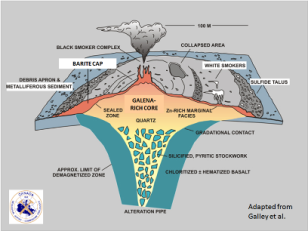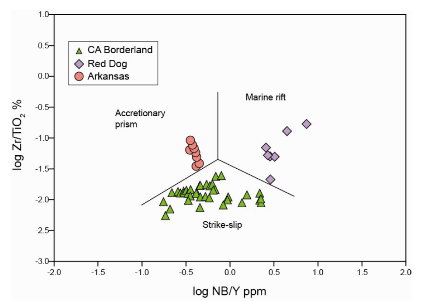Shale-hosted barite DEPOSITS
Commercial deposits of barite are dominated by a few large, bedded deposits hosted by deep-water mudstones. Secondary occurrrences are as veins or as arrays of nodules. At one time, residual deposits, formed during deep leaching of limestones, were important, but not today. The bedded deposits are found in two major types -- those associated with significant Pb-Zn mineralization, and those that are Ba only. The base metal-associated deposits form in rift basins, whereas the barren barites occur in subduction-zone accretionary prisms or in strike-slip generated transtensional basins.

RIFT-RELATED DEPOSITS. Many, if not most, shale-hosted Pb-Zn deposits have a major zone of barite mineralization above or lateral to the deposit. Many volcanic-hosted Pb- Zn deposits do as well. The famous Kuroko (= "black ore") deposits of Japan are named for their barite component. The common presence of this BaSO4mineralization suggests a major involvement of seawater in the mineralization process and close proximity to the seafloor at the time of ore deposition.
SUBDUCTION-RELATED DEPOSITS. Many ancient barite-only deposits are associated with the initiation of accretionary prism deposition in subduction zones. The Peru margin contains similar deposits in the modern. These are cold-water deposits, in contrast to the hot-water deposits of rifts. The ore-transporting fluid is likely reducing pore waters squeezed from the prism along detachment faults. Barite then precipitates where these fluids emerge and mix with SO4-bearing seawater.
STRIKE-SLIP RELATED DEPOSITS. In both the modern and the Miocene, the Southern California Continental Borderland was host to barite mineralization. These were also cold-fluid vents, accounting for their low metal contents.
DIFFERENTIATING AMONG DEPOSIT TYPES. Some separation of deposits can be achieved by measuring Sr isotopes, but the best discriminator is the array of resistant trace elements in minor volcanics associated with the host shales. A plot of log Zr/TiO2 v log Nb/Y separates these classes of deposit:

